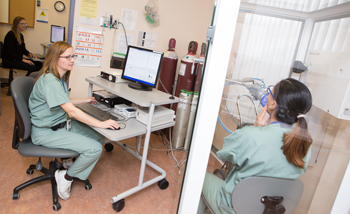New software has respirologists breathing easy

By Kelly O’Brien

Dr. Marie Faughnan (left, in background), director of the Pulmonary Function Lab, and Eva Leek (centre), a respiratory therapist, led the team that brought Influx reporting software to the respirology unit. (Photo by Yuri Markarov)
A respirology team is using new software to improve workflow and reduce errors in diagnostic reporting in the Pulmonary Function Lab.
The software, developed by Influx Workflow Solutions, extracts patient data from a range of diagnostic devices and consolidates multiple reports in a single reporting software. The report can then be viewed quickly and easily by respirologists and other caregivers.
Prior to installing the software, a number of factors disrupted the workflow, according to Dr. Marie Faughnan, a respirologist and director of the Pulmonary Function Lab.
“In short, we did not have a very efficient setup,” she said.
The Pulmonary Function Lab does a wide range of diagnostic tests and each machine produces a different report. With Influx, physicians and staff can access all of a patient’s reports, instead of collecting separate reports from each machine.
“Tests include spirometry, lung volumes, lung diffusing capacity, airway resistance and exercise oximetry among others,” said Eva Leek, a respiratory therapist. “Now, we can gather all reports from just one workspace and see a complete view of the patient’s respiratory status.”
St. Michael’s is also a teaching hospital, so there are extra steps in the reporting process to accommodate training responsibilities.
Did you know? The Pulmonary Function Lab at St. Michael’s is one of largest and busiest in Toronto. |
“A report is generated by the Pulmonary Function Lab, goes to the resident and then on to the respirologist for review and a teaching-moment discussion,” said Dr. Faughnan.
This made for a workflow that was slow and prone to error. While preliminary reports might be in clinical hands within a day, full diagnostic reports sent back to referring physicians could take a week or more to produce.
The team needed a system that was user-friendly, fast and made reports easy to interpret and integrate with the patient’s electronic health record, said Dr. Faughnan.
The software was integrated with the hospital’s existing cardiology PACS system for immediate physician reporting. The new system eliminates time-consuming steps in the reporting process, automates old paper-based systems and reduces the potential for errors.
Preliminary respiratory reports now are available in patients’ electronic charts almost immediately after being written. Final reports are not far behind, often showing up the same day.
“It did take us longer than expected, but what got us through it was the effort all the people at the hospital put into this,” said Leek. “We kept working together over the past year to get us where we are today.”
About St. Michael’s Hospital
St. Michael’s Hospital provides compassionate care to all who enter its doors. The hospital also provides outstanding medical education to future health care professionals in more than 29 academic disciplines. Critical care and trauma, heart disease, neurosurgery, diabetes, cancer care, care of the homeless and global health are among the Hospital’s recognized areas of expertise. Through the Keenan Research Centre and the Li Ka Shing International Healthcare Education Centre, which make up the Li Ka Shing Knowledge Institute, research and education at St. Michael’s Hospital are recognized and make an impact around the world. Founded in 1892, the hospital is fully affiliated with the University of Toronto.
